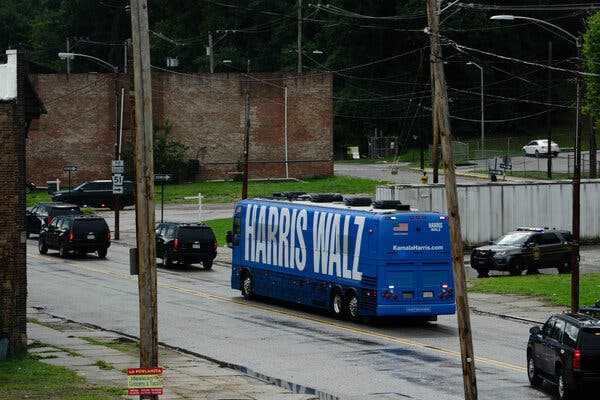A $500,000 program will send canvassers in the critical battleground state out to voters with locally tailored messages.
- Share full article

The Harris-Walz campaign bus in Aliquippa, Pa., just north of Pittsburgh, this month. Their party is conducting what it calls its largest and most coordinated campaign in the state.
The Pennsylvania Democratic Party began a program Wednesday to give locally tailored messaging to canvassers across the state, for candidates from the Harris-Walz ticket down to school boards.
The party said it was the largest and most coordinated campaign it had conducted in Pennsylvania.
Canvassers will have highly targeted talking points. In a town where conservatives control the school board, the focus might be on book bans; in a rural county without good internet access, it might be on broadband funding from the infrastructure bill President Biden signed; in Pittsburgh, where a bridge collapsed in 2022, it might be on funding for road repairs.
The canvassers will also have campaign literature to give out, tailored to each of the state’s 67 counties and 203 State House districts, or even smaller areas. Each piece of literature — there are 395 in all — will have a QR code leading to a list of every candidate on local ballots and to voting information like polling locations that can be updated daily if details change.
The state party is spending at least $500,000 on the effort, called Vote Local PA.
The program is an acknowledgment of Pennsylvania’s central role this year. Its 19 electoral votes could tip the race between Vice President Kamala Harris and former President Donald J. Trump. The re-election campaign of Senator Bob Casey, a Democrat, could decide control of the Senate. At least four House races are competitive, and both chambers of the divided state legislature could flip.
But Vote Local PA is also an attempt to address a serious vulnerability for Democrats: the extent to which their base has consolidated toward cities. Though the party has gained ground in the suburbs, it has hemorrhaged support in exurban and rural areas, forcing it to rely more on high turnout and overwhelming margins in its strongholds.
We are having trouble retrieving the article content.
Please enable JavaScript in your browser settings.
Thank you for your patience while we verify access. If you are in Reader mode please exit and log into your Times account, or subscribe for all of The Times.
Thank you for your patience while we verify access.
Already a subscriber? Log in.
Want all of The Times? Subscribe.
SKIP ADVERTISEMENT
Source: nytimes.com



